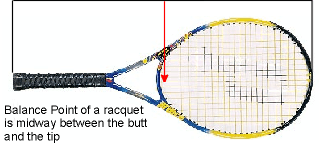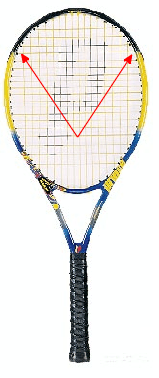Customizing Your Racquet, Part 2
It's a Matter of Weight and Balance
by Kevin Pope
With racquets getting lighter and lighter,
customizing a racquet to your particular needs has become more
and more important. It is rare on the pro tour to find a player
playing with a racquet right off the shelf. A racquet can be customized
both in terms of weight and balance. This article deals with
balance. In Part I we addressed
weight.
Racquet balance, the indicator of weight distribution, is
easily measured. The
balance position of a racquet is referenced to the mid-point
of the frame (halfway between the butt and the tip). For
a 27-inch long racquet, this reference point is 13.5 inches from
the butt end. Traditional tennis racquets weighed 11.5-13
ounces with a balance point located slightly (or more) toward
the handle. Keeping these racquets head-light made them
more maneuverable than evenly balanced racquets of the same weight.
Manufacturers have introduced extremely lightweight, head-heavy
racquets. These companies
assert that moving the balance point further toward the head
 also
raises the sweetspot to where most players make ball contact,
without sacrificing maneuverability.
Whereas traditionally weighted racquets generally have
balance points ½ to 1½ inches toward the handle,
some of the newer lightweight, head-heavy racquets balance 1-2
inches toward the head. also
raises the sweetspot to where most players make ball contact,
without sacrificing maneuverability.
Whereas traditionally weighted racquets generally have
balance points ½ to 1½ inches toward the handle,
some of the newer lightweight, head-heavy racquets balance 1-2
inches toward the head.
Balance has typically been expressed in “points”
head-light or “points” head-heavy. One
point = 1/8 inch. For
example, a 27” racquet with a balance point of 12-1/2 inches
(measured from the butt end) is 1 inch or 8 points head-light.
With the advent of extended length tennis racquets, it may
become necessary to modify the use of terminology such as “head-light”
and “head-heavy.” When
all tennis racquets were equal in length, even balance point
was universal-13.5 inches (34.3 centimeters). Armed
with a racquet’s weight and balance specifications, it was
possible to categorize racquets based on their maneuverability,
using point or inches head-light or head-heavy. Applying
this method to racquets of different lengths, though, is like
comparing apples to oranges.
“With the introduction of 28”, 28-1/2” and
29” racquets, the current balance specifications can be
very misleading,” observes Dr. Howard Brody, USRSA technical
advisor and Professor of Physics at the University of Pennsylvania. “The
terms balanced, head-light and head-heavy are not absolute measurements
since they refer to the racquet’s mid-point, and therefore
depend on the racquet’s length.”
“A 10-ounce, evenly balanced, 29-inch racquet will not
feel and swing the same as a 10-ounce, evenly balanced 27-inch
racquet. When you pick
up the 29-inch, evenly balanced racquet, it will feel the same
as if it were a 27-inch (one inch head-heavy) racquet of the
same weight. That is because
the reference (even balance) point is one inch further out than
the reference point on the 27-inch racquet.” A 29-inch racquet, therefore, weighing the same
as a 27-inch racquet, would need to have a balance point one
inch closer to the handle (half the increase in length) to feel
the same when swung. Using this formula, a 28-inch racquet weighing
the same as a 27-inch racquet would require a balance point ½”
closer to the handle to feel the same.
Moment
“This is all about how the racquet feels when you pick
it up and just hold it (by the handle). That
feeling, called the first moment (or static moment), is the weight
of the racquet multiplied by the distance of the balance point
from your hand. The higher
the value of first moment, the heavier the racquet will feel. A
racquet weighing 300 grams, with a balance point of 32 centimeters
has a first moment of 96 gram-meters
(32 X 300/ 100). (Balance
point is measured from the butt end for consistency.) A
racquet weighing 340 grams with the same balance point would
have a first moment of 109 gram-meters, or would feel approximately
14% heavier. While first
moment may quantify the feeling of picking up a racquet, what
you feel when you swing a racquet is known as the second (or
dynamic) moment, also known as the moment of inertia or swingweight.”
Swingweight
Swingweight (or moment of inertia) is
probably the most important characteristic in determining the
feel and maneuverability of a racquet during play. Racquets
with a greater swingweight tend to feel heavier and less maneuverable
than a lower swingweight racquet of similar static weight and
balance.
Adding weight at 2 and 11 o'clock increases
swingweight and stability

|
Two racquets of identical weight and balance
can have very different swingweights, and therefore will perform
differently. To illustrate,
imagine two poles with two weights attached. If
the weights are affixed at opposite ends, the swingweight of
the pole is maximized. However,
if the weights are closely situated, swingweight is minimized. Two racquets balanced this way will have totally
different playing characteristics. Yet
they will be identical in weight and balance.
The same holds true with racquets of differing
lengths. The 10 ounce,
evenly balanced 29 inch racquet discussed earlier, will have
a completely different feel in motion than a 10 ounce, evenly
balanced 27 inch racquet. In
order to equalize the swingweight of these two racquets, the
balance point of the 29 inch racquet would need to be placed
one inch closer to the handle, since the even balance point is
one inch further than a 27 inch racquet (14-1/2 inches vs. 13-1/2
inches).
When customizing racquets, putting weight
at the frame’s tip increases swingweight but not torsional
stability. A good
compromise is to add weight at 1-2 and 10-11 o’clock on
the frame. Such placement
increases the frame’s swingweight and torsional stability.
Frame manufacturers use sophisticated
equipment to determine swingweight. Experimentation is really
the only way to arrive at the best weight, balance, and swingweight
for an individual player. A
good scale, a balance board and a supply of lead tape will go
a long way towards customizing your racquet. Pro players use
sophisticated diagnostic equipment that you will be able to find
through a USRSA certified stringer.
The information in this article was provided
by the USRSA. They are the know all and end all to stringing
and racquet customization. If you have any questions or need
help contact their website for a certified stringer in your area. |
![]()
